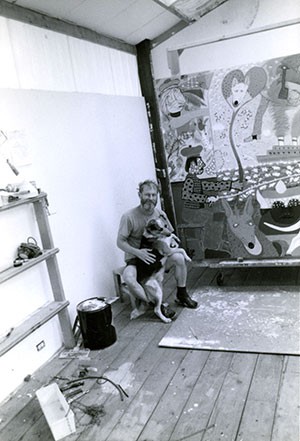Born 1930, North Platte, Nebraska
Died 2007, Vallejo, California
Roy De Forest arrived in San Francisco in 1950 to attend the California School of Fine Arts (CSFA), then taught at the University of California, Davis, for almost three decades. Far from New York, the Bay Area fostered an aesthetic labeled “funk” by Peter Selz of the University of California’s Berkeley Art Museum in 1967. This predilection for the eccentric, “lowbrow,” and seemingly unsophisticated was shared by Jim Nutt and Gladys Nilsson of the Chicago imagist group the Hairy Who, based in northern California between 1968 and 1970. While De Forest, who showed in New York, rejected the funk label, he exhibited with Nutt and others at the Candy Store Gallery in Folsom, California. Spurred by Nutt’s interest in self-taught art, CSFA curator Phil Linhares organized American Primitive and Naïve Art in 1970, connecting West Coast styles, largely marginalized as regional, with the nascent attraction to “outsider” art.
In the late 1950s De Forest first broke with the dominant abstract expressionist idiom and began to make narrative paintings, embracing popular and fantastic imagery. One critic described his works as a California version of Edward Hicks’s Peaceable Kingdom series, referring to De Forest’s cosmological landscapes inhabited by animals that morph with cartoonlike elasticity. Many of his paintings resemble tightly woven hallucinatory quilts of vivid, even garish color, unregulated by conventions of perspective. Their surfaces host the glittering rhythm of his hallmark dabs of paint, which have been likened to candy kisses, stiff peaks of meringue, jewels, and chocolate chips. De Forest was also known for painted, multimedia constructions. Unlike most works associated with assemblage, his bas-relief sculptures remain oriented primarily toward the picture plane.
The Young Wordsworth represents a childlike character painted on a slab of wood, with hand-carved doodads coated in vibrant colors that adorn the surface and congregate into an altarlike ensemble. De Forest—like H. C. Westermann, whom he greatly admired—drew on vernacular woodcarving to convey a tactile sense of directness. Artist Peter Saul and his wife, Sally, acquired this work, testifying to a sensibility that De Forest shared with Saul, with whom he taught at Davis and whose cartoonishly grotesque paintings inspired the Chicago imagists.
Jenevive Nykolak
Landauer, Susan. Of Dogs and Other People: The Art of Roy De Forest. Oakland: University of California Press with the Oakland Museum of California, 2017.
Roy De Forest. Davis, CA: Natsoulas/Noveloza Gallery Press, 1990.
